The heeling of a sailboat or yacht, i.e. the inclination to the side, is normal within certain limits, depending on the type and nature of the boat. Nevertheless, excessive rotation of the watercraft around its longitudinal axis can cause discomfort to the crew. SeaHelp offers tips on how to reduce the rolling motion that causes the vessel to heel to a tolerable level to avoid seasickness, and how to avoid list and capsize.
First of all, a certain amount of heeling is perfectly normal at sea and even unavoidable to a certain extent. The heeling is thereby harmless for the ship and its crew as long as it remains within the limits specified by the type of ship. But when are these limits exceeded? And what can be done on board to ensure that the boat heels only within tolerable limits, if at all, so that the crew on board does not become uncomfortable?
If you want to avoid excessive rotation of the hull around its longitudinal axis on your yacht, you should first know that heeling torques can be caused primarily by swell and wind pressure, but also by certain centrifugal forces, incorrect weight trim or a lateral hawser pull during towing.
Rolling and pitching in swells can be reduced by an adjusted course
Increasing wave heights inevitably lead to increasing rolling or pitching motion aboard a yacht. Since heeling due to swell is dependent on the direction of the waves (compared to the course being followed), the pitching here can at least be reduced by an adjusted course (no “counter pitching”). In addition, ship stabilizers are installed on larger yachts to reduce the effect of rolling or pitching in the waves. This is to prevent the so-called seasickness.
With sailboats, a certain amount of heeling is unavoidable – at least when heading upwind. Seagoing yachts often have a large angle of capsize around 120 degrees, which means that the increasing wind pressure can push the ship to the shallow water at the maximum. Attention: this does not apply to multihulls, here it is essential to reef in time.
Refing in time helps to keep heeling within limits
By reefing, that is, reducing the sail area, you can avoid too much heeling even on monohulls (monohull sailboats). The following applies: when you first think about reducing the sail area on board (furling the sail a bit, classically tying in a reef or attaching a smaller sail), you should reef – otherwise it might be too late.
Moderate “opening” of the sails can also lead to a stronger righting moment on board. So you can’t “run height” with the yacht as much, but the crew will thank the skipper by the fact that there will be no failures on board due to seasickness, because the crew feels more comfortable and safe -.
It only becomes dangerous when heeling turns into list and eventually capsize
So-called “centrifugal forces in the turning circle” can also lead to excessive heeling, to list and, under certain circumstances, even to capsizing. This is especially true of motorboats, and occurs when they make tight turns too quickly. The same is true for slipped cargo on board, plus improper weight trim can cause severe heeling. And in the case of a hawser pull (when towing), it should always be noted that the forces act on the longitudinal axis (front) of the boat and never laterally.
Remember: too much heeling can cause the boat to capsize. Either the heeling leads to water ingress or cargo slippage, or the forces acting are so great that the righting forces of the hull are no longer sufficient.
Some heeling on yachts is normal; keelboats function like a stand-up man
At the same time, heeling on yachts is generally not bad per se in the first place: after all, the increased heeling allows too much wind out of the sheets, which means that, for example, in the event of a sudden strong gust of wind, the attack surface is thus automatically reduced up to a certain point. Another way to sail through a gust unscathed is to “pinch”, i.e. an increased upwind course, not suitable for longer trips in adverse conditions.
Physically, the keel (in sailing yachts) acts as a counterweight to heeling. This contains up to 50 percent of the mass of the ship and thus normally causes a righting moment. A certain amount of heeling of 20 to 45 percent is quite normal here – depending on the design of the yacht and the strength of the wind – and should not pose a danger to the ship. This is because the stronger the heel, the stronger the righting moment of the keel will be due to the law of leverage (standing man principle).
It is recommended to trim – to counteract excessive heeling on board
In catamarans or trimarans, the off-center floats allow a greater value for shifting the center of buoyancy, creating a righting moment. Catamarans therefore do not capsize until the heel reaches 90 degrees. Small dinghies do not have a keel, but only a centerboard due to their design, which usually has relatively little mass. Therefore, the crew must counteract the heeling by riding out to windward (trimming).

In general, “trimming” is recommended if you want to counteract excessive heeling on board. With keelboats as well as with catamarans or dinghies, the heeling can be reduced by the crew “sitting on the high edge”, i.e.: sitting upwind at the railing. If then still – in time before – the sail area was reduced according to the wind conditions (reefing), nothing should stand in the way of a carefree trip.
Who wants to play it safe, sails rather under-rigged than over-rigged, in any case, the sailing wardrobe should always be adapted to the wind conditions
A safety-conscious skipper will also always sail with a sailing wardrobe that is perfectly adapted to the wind and weather conditions (under-rigged rather than over-rigged); this accommodates the well-being of all on board, increases safety on board and preserves the material.
Nevertheless, he should be receptive to the signals of the crew, interpret them correctly, and, if necessary, break off or interrupt a trip if the whistle is too strong and the yacht is leaning to one side more than usual despite all countermeasures. And if, despite all safety measures, the yacht does start to list, it’s good to have the SeaHelp contacts at hand: either via App or by phone: Europe-wide on 0043 50 43 112. How to make an emergency call correctly can be found here.













